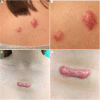Current Therapeutic Approach to Hypertrophic Scars
- PMID: 28676850
- PMCID: PMC5476971
- DOI: 10.3389/fmed.2017.00083
Current Therapeutic Approach to Hypertrophic Scars
Abstract
Abnormal scarring and its accompanying esthetic, functional, and psychological sequelae still pose significant challe nges. To date, there is no satisfactory prevention or treatment option for hypertrophic scars (HSs), which is mostly due to not completely comprehending the mechanisms underlying their formation. That is why the apprehension of regular and controlled physiological processes of scar formation is of utmost importance when facing hypertrophic scarring, its pathophysiology, prevention, and therapeutic approach. When treating HSs and choosing the best treatment and prevention modality, physicians can choose from a plethora of therapeutic options and many commercially available products, among which currently there is no efficient option that can successfully overcome impaired skin healing. This article reviews current therapeutic approach and emerging therapeutic strategies for the management of HSs, which should be individualized, based on an evaluation of the scar itself, patients' expectations, and practical, evidence-based guidelines. Clinicians are encouraged to combine various prevention and treatment modalities where combination therapy that includes steroid injections, 5-fluorouracil, and pulsed-dye laser seems to be the most effective. On the other hand, the current therapeutic options are usually empirical and their results are unreliable and unpredictable. Therefore, there is an unmet need for an effective, targeted therapy and prevention, which would be based on an action or a modulation of a particular factor with clarified mechanism of action that has a beneficial effect on wound healing. As the extracellular matrix has a crucial role in cellular and extracellular events that lead to pathological scarring, targeting its components mostly by regulating bone morphogenetic proteins may throw up new therapeutic approach for reduction or prevention of HSs with functionally and cosmetically acceptable outcome.
Keywords: hypertrophic scar; prevention; scar management; skin scarring; topical therapy; treatment; wound healing.
Figures
References
Publication types
LinkOut - more resources
Full Text Sources
Other Literature Sources
Medical
Research Materials


